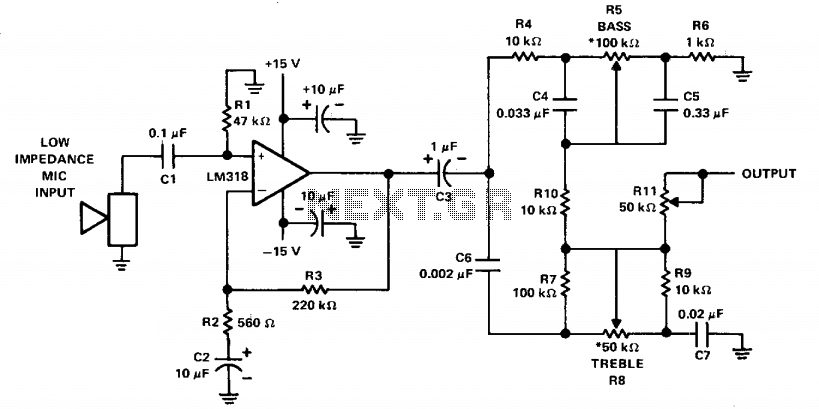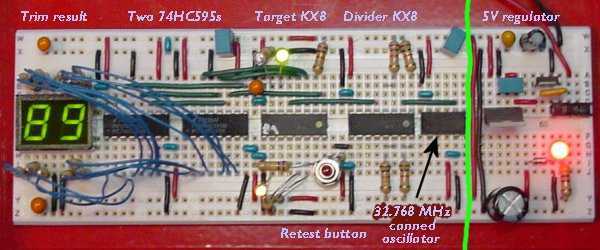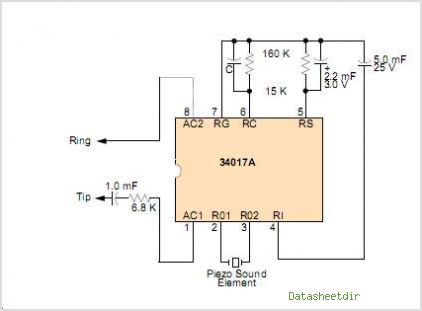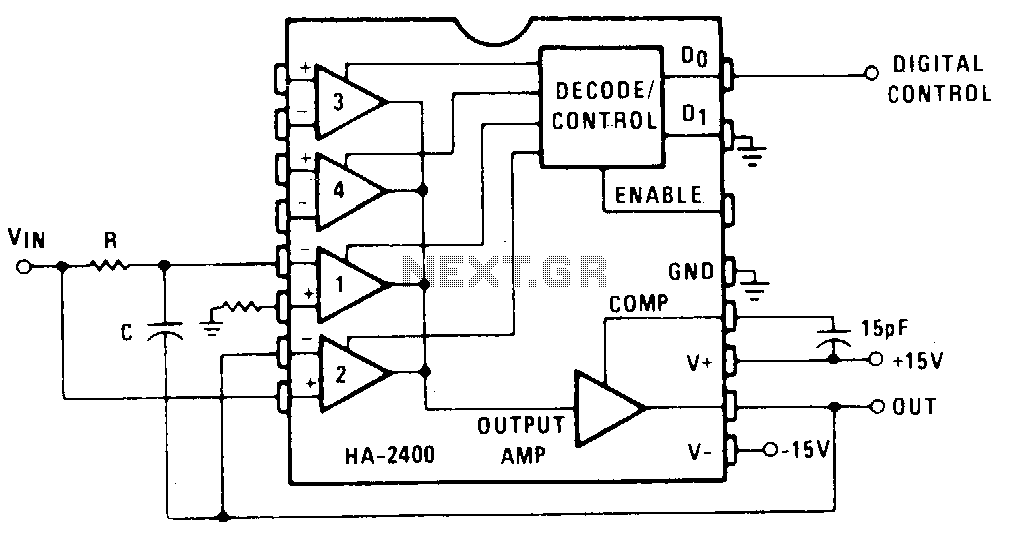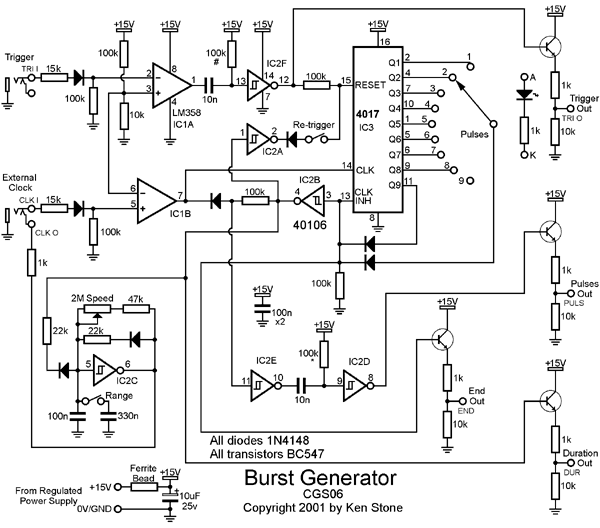
Tone burst generator
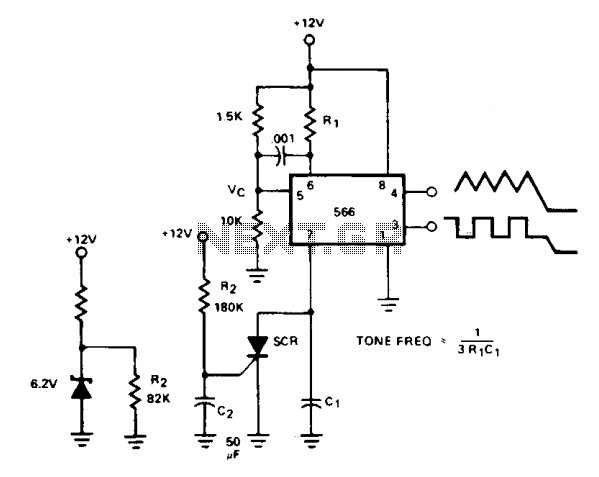
The tone burst generator provides a tone for half a second once the power supply is activated, serving as an alert signal for a communications network. The tone stops when the silicon-controlled rectifier (SCR) is activated, which diverts the charging current of timing capacitor C1. The SCR is triggered when capacitor C2 reaches the gate voltage, which occurs within 0.5 seconds. Given that only 70 µA is available for triggering, the SCR needs to be sufficiently sensitive to activate at this current level. To enhance the triggering current, the resistance R2 can be decreased, while capacitor C2 may be increased to maintain the same time constant. To ensure the tone duration remains constant despite fluctuating supply voltage, an optional Zener diode regulator circuit can be integrated, requiring a new resistance value for R2, specified as R2' = 82 kΩ. Alternatively, if the SCR is substituted with an NPN transistor, the tone can be controlled for activation and deactivation via the base terminal of the transistor.
The tone burst generator circuit is designed to provide a reliable alert signal in communication networks. Upon activation, a timing mechanism initiates the generation of a tone for a precise duration of 0.5 seconds. The SCR plays a crucial role in controlling the cessation of the tone by diverting the current from the timing capacitor C1 once it is triggered. The timing capacitor C2 is integral to the triggering process, as it charges to a specific gate voltage necessary to activate the SCR.
To ensure the SCR functions correctly, it must be sensitive enough to trigger with the limited current of 70 µA. Adjusting R2 to a lower resistance can increase the triggering current, which may be necessary in scenarios where the SCR's sensitivity is inadequate. The potential adjustment of C2 is also important, as it helps maintain the desired time constant for the tone burst.
For applications requiring consistent tone duration across varying supply voltages, the integration of a Zener diode regulator circuit is advisable. This addition stabilizes the voltage supplied to the circuit, ensuring that the timing remains unaffected by fluctuations in the power supply. The adjustment of R2 to a new value of 82 kΩ is necessary to accommodate this change while preserving the circuit's functionality.
In cases where more flexible control of the tone is required, replacing the SCR with an NPN transistor offers an effective solution. This modification allows the tone to be turned on and off at will, providing greater control over the alert signal. The base terminal of the transistor serves as the control point, enabling rapid activation and deactivation of the tone burst as needed. This versatility can be particularly beneficial in dynamic communication environments where timely alerts are critical.The tone burst generator supplies a tone for one-half second after the power supply is activated; its intended use is a communications network alert signal. Cessation of the tone is accomplished at the SCR, which shunts the timing capacitor CI charge current when activated.
The SCR is gated on when C2 charges up to the gate voltage which occurs in 0.5 seconds. Since only 70 ?? are available for triggering, the SCR must be sensitive enough to trigger at this level. The triggering current can be increased, of course, by reducing R2 (and increasing C2 to keep the same time constant). If the tone duration must be constant under widely varying supply voltage conditions, the optional Zener diode regulator circuit can be added, along with the new value for R2 R2' = 82 kfi.
If the SCR is replaced by an npn transistor, the tone can be switched on and off at will at the transistor base terminal. 🔗 External reference
The tone burst generator circuit is designed to provide a reliable alert signal in communication networks. Upon activation, a timing mechanism initiates the generation of a tone for a precise duration of 0.5 seconds. The SCR plays a crucial role in controlling the cessation of the tone by diverting the current from the timing capacitor C1 once it is triggered. The timing capacitor C2 is integral to the triggering process, as it charges to a specific gate voltage necessary to activate the SCR.
To ensure the SCR functions correctly, it must be sensitive enough to trigger with the limited current of 70 µA. Adjusting R2 to a lower resistance can increase the triggering current, which may be necessary in scenarios where the SCR's sensitivity is inadequate. The potential adjustment of C2 is also important, as it helps maintain the desired time constant for the tone burst.
For applications requiring consistent tone duration across varying supply voltages, the integration of a Zener diode regulator circuit is advisable. This addition stabilizes the voltage supplied to the circuit, ensuring that the timing remains unaffected by fluctuations in the power supply. The adjustment of R2 to a new value of 82 kΩ is necessary to accommodate this change while preserving the circuit's functionality.
In cases where more flexible control of the tone is required, replacing the SCR with an NPN transistor offers an effective solution. This modification allows the tone to be turned on and off at will, providing greater control over the alert signal. The base terminal of the transistor serves as the control point, enabling rapid activation and deactivation of the tone burst as needed. This versatility can be particularly beneficial in dynamic communication environments where timely alerts are critical.The tone burst generator supplies a tone for one-half second after the power supply is activated; its intended use is a communications network alert signal. Cessation of the tone is accomplished at the SCR, which shunts the timing capacitor CI charge current when activated.
The SCR is gated on when C2 charges up to the gate voltage which occurs in 0.5 seconds. Since only 70 ?? are available for triggering, the SCR must be sensitive enough to trigger at this level. The triggering current can be increased, of course, by reducing R2 (and increasing C2 to keep the same time constant). If the tone duration must be constant under widely varying supply voltage conditions, the optional Zener diode regulator circuit can be added, along with the new value for R2 R2' = 82 kfi.
If the SCR is replaced by an npn transistor, the tone can be switched on and off at will at the transistor base terminal. 🔗 External reference

